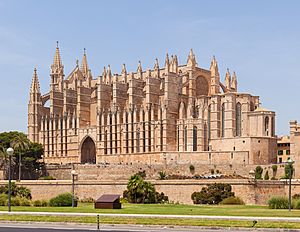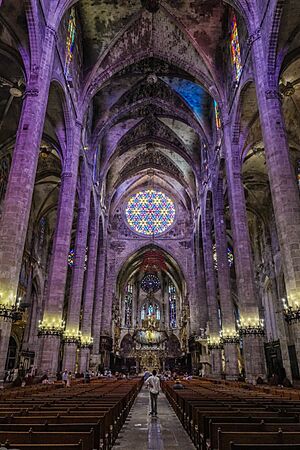Palma Cathedral facts for kids
Quick facts for kids Palma CathedralCatedral de Santa María de Palma de Mallorca |
|
|---|---|

The Cathedral of Palma viewed from the shoreline
|
|
| Religion | |
| Affiliation | Roman Catholic |
| Location | |
| Location | Palma, Spain |
| Architecture | |
| Architectural type | Church |
| Architectural style | Gothic |
| Groundbreaking | 1229 |
| Completed | 1601 |
| Specifications | |
| Direction of façade | North-West |
| Length | 121m |
| Width | 40m |
The Cathedral of Santa Maria of Palma, often called La Seu, is a huge Gothic Roman Catholic church in Palma, Mallorca, Spain. It's the main church for the diocese of Mallorca. You can find it right by the sea in Palma, next to the old city walls. It sits between the Royal Palace of La Almudaina and the Bishop's Palace.
This cathedral is famous for a few things. Its large round window, called a rose window, is almost 14 meters wide. It's the second-biggest Gothic rose window still around. Also, the main part of the church, called the nave, is 44 meters high. This makes it one of the tallest church naves in the world!
Before the cathedral was built, a mosque stood on this spot when Muslims ruled the island. Building the cathedral started soon after the island was taken back in 1229. Work continued for many years, finishing in the 17th century. Today, the cathedral is one of Palma's most popular places to visit.
Contents
History of the Cathedral
The city of Palma was once called Madina Mayurqa. It was taken from its Muslim rulers in 1229. This happened during the first part of the conquest of Majorca. King James I quickly brought back the Catholic Church to Mallorca. Building work then began on the site of Madina Mayurqa's largest mosque.
The earliest part of the cathedral that still exists today is the Chapel of the Holy Trinity. It was finished in 1327. This chapel was meant to be a burial place for the Kings of Mallorca. By 1386, the cathedral started to look like it does now, and all signs of the old mosque were gone. The bell tower was completed in 1498. Around the same time, the main parts of the church and their arched ceilings were also finished.
Later, in the 19th century, the front of the cathedral was changed. It used to have a flat top. But because of some building problems, it was rebuilt in a new Gothic style. This gave the front its current pointed shape.
Antoni Gaudí's Work
A famous architect named Antonio Gaudí was asked to help with repairs in 1903. He made many big changes inside the cathedral. His goal was to make the church services feel closer to the people. However, some people didn't like his changes. They felt he removed or changed too much of the older decorations.
Gaudí moved the choir stalls and a screen that were in the middle of the church. He put them along the side walls near the altar. He also designed a large canopy to hang above the altar. Older altarpieces were removed to highlight the 13th-century Bishop's Chair and the tombs of Kings James II and James III.
Gaudí also opened up windows that had been bricked up. This let in more natural light. He designed special ceramic panels for the choir with royal symbols. Gaudí and his team stopped working at the cathedral in 1914. This was because of disagreements with the local leaders. Even though his big plans were not fully finished, Gaudí's work greatly changed how the cathedral looks inside today.
Modern Art by Miquel Barceló
The most recent major changes to the cathedral happened between 2001 and 2006. A Mallorcan artist named Miquel Barceló worked on the Chapel of Sant Pere and the Holy Sacrament. This chapel is at the end of the southern part of the church.
Barceló completely redid the chapel to show the Miracle of Loaves and Fishes and the Wedding at Cana. He covered the entire back wall with Italian ceramic art. He also designed new furniture for the chapel. He replaced the old stained glass with new glass that looks like the bottom of the sea. This project caused a lot of discussion because it was a very modern change to a historic place. However, with the support of Mallorca's bishop, the project was completed.
Cathedral Structure
The cathedral has three long sections, called naves, that run side-by-side. Each nave has an arched end section, called an apse. Many experts believe this design was influenced by other churches built around the same time in Barcelona. The cathedral does not have a cross-shaped layout inside.
The main nave is 40 meters high, making it the 8th-highest in the world. The pillars that hold up the arched ceilings are very thin compared to the size of the arches. They are only 1/12th the width of the arch. For comparison, in Reims Cathedral, the pillars are 1/6th the width. The entire cathedral is 121 meters long and 40 meters wide.
The cathedral's famous east rose window is seen on many tourist items. It is the second-largest Gothic rose window in the world, after the one in Strasbourg Cathedral. It takes up almost the entire width of the central nave.
Exterior Design
The outside of the cathedral looks very tall. It uses many flying buttresses and pinnacles. These are supports and pointed decorations that help hold up the walls and make the building look grand. Both sides of the cathedral are built in three levels. The lowest level has the sacristy and chapels. The middle level contains the two side naves. The highest level encloses the main nave.
In the late 19th century, the west front of the cathedral was rebuilt in a new Gothic style. This change made the triangular shape of the inside more obvious on the outside. The two side naves are only half the height of the central one. Except for the main entrance, the entire west front was rebuilt in this French-inspired new Gothic way.
Inside the Cathedral
The Royal Chapel is at the end of the central nave. This is the oldest part of the cathedral. It holds the tombs of Mallorcan Kings James II and III. Their elaborate marble tombs are next to the Bishop's Throne, which was made in 1346 from white marble.
There are sixteen chapels along the nave. These chapels show almost all the different building styles used in Mallorca since the cathedral was built. They range from the detailed Plateresque style of the Chapel of Sant Jeroni to the fancy Churrigueresque style of the Chapel of Our Lady of the Crown. There's also the modern chapel of Sant Pere, which was redone by Miquel Barceló.
The cathedral also has many different kinds of funeral monuments. The choir stalls, which Gaudí moved and changed, number 110. They are a great example of Catalan Gothic wood carving.
See also
 In Spanish: Catedral de Palma de Mallorca para niños
In Spanish: Catedral de Palma de Mallorca para niños
- Catholic Church in Spain
- List of highest church naves


